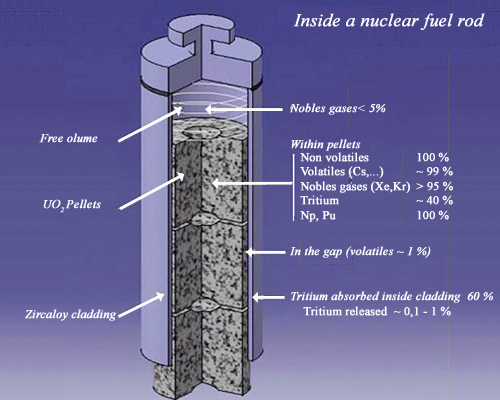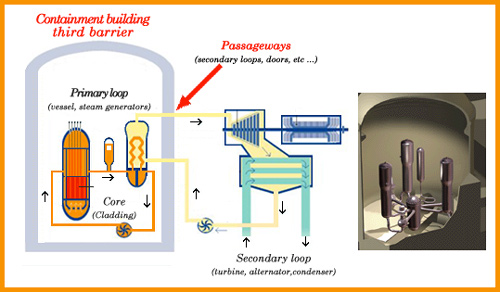Three barriers …
One major challenges of nuclear installations safety is to master the confinement of radioactivity under all circumstances.
Above all, an accidental release of radioactive materials into the environment should be avoided. The method for this is to monitor closely the three barriers that, in normal operation, are interposed between these dangerous products and the atmosphere.

First barrier : fuel cladding
The first barrier against the release of radioactive products is the cladding encasing the fuel. Some radioelements being gaseous or made volatile by high temperatures, an expansion volume is provided at the rod top to prevent overpressure. Other radioelements, such as plutonium, remain trapped in the uranium oxide pellets. The zirconium alloy cladding, transparent to neutrons, provides an excellent containment of radioactivity notwithstanding the conditions of temperature and pressure.
© IN2P3
1 : The first barrier is the cladding wrapping the fuel rods, more than 40 000 of them in the core of a PWR reactor. The radioactive products generated in the fuel pellets are retained within the cladding. The cladding is in normal conditions perfectly hermetic, the only exception being tritium. More than few minor leaks without significant consequences, one should avoid above all a rupture, or even a fusion of a large number of claddings caused by poor heat dissipation. Hence the importance attached to the effective cooling of the core reactor.

The second barrier
The second barrier is provided by the walls of the reactor pressure vessel and steam generators, belonging to the primary loop through which circulates the pressurized hot water. The diagram of a steam generator (right) shows the primary water bathing the tubes of the secondary circuit. The confinement of the radioactivity that eventually leaks into the primary water is provided by the walls of the pressure vessels and of the steam generators.
© EDF
2 : The primary loop: The fuel rods are immersed in the primary water circulating in a closed loop between the core and the steam generators: The primary circuit is a second envelope able to retain the dispersion of radioactive products contained in the fuel in the event of cladding failures. Activated by neutrons, the chemicals products contained in the primary water, such as boron, lithium and the corrosion products coming from the metallic surfaces, contribute to this radioactivity. The circuit is confined inside a large steel pressure vessel with walls up to 30 cm thick

The third barrier
The third barrier is provided by the reactor building enclosure. This external containment structure is maintained in depression, preventing that radioactivity in the reactor building escapes outside. The passageways should be carefully isolated. The good performance of this containment has prevented a large dispersion of radioactive materials in the case of the major Three Mile Island accident in 1979. The drawing on the right displays the inside of the building.
© AREVA / EDF
3 : The containment structure: it is constituted by the large cylindrical building that houses the primary circuit building and is designed to ensure the best possible isolation. The reinforced concrete walls of this robust containment structure are at least one metre thick. The passageways for the pipes and the electrical systems as well as access doors for personnel and introduction of equipment are insulated to ensure containment of the structure in the event of simultaneous leaks of the first and second barriers.
Many safety features are designed to ensure containment of radioactivity in the case of the worst scenarios of barriers failure. The safety of nuclear power plants in particular is based on the philosophy of Defence in Depth. The multiple levels of protection, including barriers described above, reduce to an extremely low level the probability that an accident could have repercussions outside the plant. Each safety device, considered a priori as vulnerable, must be backed by another independent device.
The principle of defence in depth is involved at all stages of the life of a nuclear plant, from its design, its implementation to the operational phase.
Other articles on the subject « Reactor Safety »
Reactors Cooling
Evacuate the heat of fissions and radioactive decays To ensure the safety of a reactor requires t[...]
Reactor Shutdown
The embers of fission … When shutting down the reactor, whether for reloading the fuel or a[...]
Reactor maintenance
Provide the best safety for reactors during decades Nuclear reactors are designed to operate for [...]